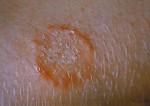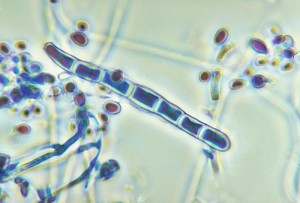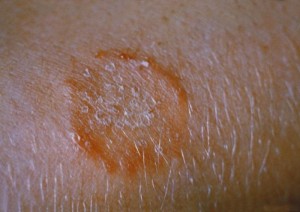Note: This blog was mistakenly blogged before the blog was to be blogged in our blog. If you read this blog before 5:30 PM PST on November 15, 2010, note that some information in this blog was changed at that time and reblogged.
You’ll sometimes hear people talking about pets – or themselves – contracting “ringworm.” With such an ominous-sounding name, it must be bad, right?
Here’s a little quiz. Don’t worry, it won’t count toward your final grade.
Which of these is ringworm most closely related to?
A. Common cold
B. Tapeworm
C. Mushroom
D. Earthworm
If you answered A, understand that ringworm isn’t a virus, and it can be treated in many ways, unlike the common cold, to which the only remedy is chicken-noodle soup.
If you answered B, you’re on the right track, but ringworm isn’t a parasite in the usual sense, and it isn’t deadly. And it isn’t a worm.
If you answered C, congratulations, you’ve won… nothing. Your answer was correct, though – ringworm is a fungus, just like the mushrooms you eat. But try not to eat ringworm, please.
If you answered D, ringworm isn’t actually a worm, and it would be difficult to catch fish with it.
So what is ringworm?
Ringworm is a contagious skin disease caused by a fungal infection, generally from either the Tricophyton rubrum [right] or Tricophyton mentagrophytes fungi.
Usually, though, when you hear people talking about ringworm, they’re referring to the symptom of this disease, itchy, red “rings” on the skin, shown on the left on a human arm. This is where ringworm gets its name.
To avoid confusion, the remainder of this post will use the scientific terms tinea corporis for the skin disease and dermatophytosis for the symptom caused by the skin disease. When referring to the infection that causes the skin disease, ringworm infection will be used, ringworm fungus for the fungi that causes the infection, and ringworm for these four elements as a whole.
In other words, ringworm consists of a ringworm fungus causing a ringworm infection causing tinea corporis causing dermatophytosis.
Ringworm can be transferred in either direction between humans and pets, most commonly cats, dogs, horses, and rabbits, in that order.
You shouldn’t be afraid of ringworm. If you see dermatophytosis on your pet or yourself, don’t panic, and don’t rush to the nearest (pet) hospital. Tinea corporis just isn’t that big of a deal. It’s not going to make you sick – it’s more similar to athlete’s foot than anything, and even less severe in many cases.
So what should you do in the case of ringworm? If you see dermatophytosis on your pet, make sure to keep it away as best you can from other pets and humans. If you contract ringworm, try to avoid contact with others, wash your hands often, and refrain from touching your eyes, nose, or mouth.
Tinea corporis can be treated and ringworm fungi killed in four ways:
- The normal best option, for pets and people, is applying over-the-counter creams to dermatophytosis-ridden areas of the skin. Look for creams to treat athlete’s foot; we recommend clotrimazole creams (brand names include Lotrimin and Mycelex).
- For more serious cases, prescription oral treatments (pills) may be given; we recommend griseofulvin (brand names include Grisovin) or itraconazole (brand names include Sporanox). Talk to your veterinarian or physician.
- For more serious cases in pets, a solution of lime sulfur (available at your local gardening store, we don’t know why) diluted (16:1 to 32:1) can be used as a pet dip. Make sure to dilute it; if you don’t, it will cause serious injuries and possibly dissolving of your pet.
- For minor cases in pets, try washing them with specialized shampoos and sprays; we recommend EQyss Micro-Tek. Make sure to read the instructions on the bottle.
It is also often recommended to use a 10:1 diluted bleach solution on household surfaces to eliminate ringworm fungus spores.
Note also that ringworm will usually die down in varying amounts of time even if left untreated.


